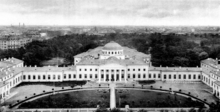Russian Constituent Assembly
|
All-Russian Constituent Assembly Всероссийское Учредительное собрание |
|
|---|---|
|
Declared by Assembly to be Russian Democratic Federative Republic, but its foundation was interrupted by Bolshevik-controlled Russian Soviet Republic. |
|

Double-headed eagle, that remained de jure coat of arms of Russia until 10 July 1918. Was never formally used prior to Assembly dissolution.
|
|
| Type | |
| Type | |
| History | |
| Established | 1917 |
| Disbanded | 1918 |
| Preceded by | Council of the Russian Republic |
| Succeeded by |
VTsIK |
| Leadership | |
|
Chairman of the Constituent Assembly
|
|
| Seats | 707 |
| Elections | |
| Direct multi-party elections via the proportional representation system | |
|
Last election
|
25 November 1917 |
| Meeting place | |
 |
|
| Tauride Palace | |
VTsIK
All-Russian Congress of Soviets
The All Russian Constituent Assembly (Всероссийское Учредительное собрание, Vserossiyskoye Uchreditelnoye sobraniye) was a constitutional body convened in Russia after the October Revolution of 1917. It met for 13 hours, from 4 p.m. to 5 a.m., 18–19 January [O.S. 5–6 January] 1918, whereupon it was dissolved by the All-Russian Central Executive Committee, making the Third All-Russian Congress of Soviets the new governing body of Russia.
A democratically elected Constituent Assembly to create a Russian constitution was one of the main demands of all Russian revolutionary parties prior to the Russian Revolution of 1905. In 1906, the Tsar decided to grant basic civil liberties and hold elections for a newly created legislative body, the State Duma. However, the Duma was never authorized to write a new constitution, much less abolish the monarchy. Moreover, the Duma's powers were falling into the hands of the Constitutional Democrats and not the Marxist Socialists. The government dissolved the Duma, as was their legal agreement, in July 1906 and, after a new election, in June 1907. The final election law written by the government after the second dissolution on 16 June [O.S. 3 June] 1907 favored the landed and ruling classes. What little the Duma could do after 1907 was often vetoed by the Tsar or the appointed upper house of the Russian parliament. The Duma was therefore widely seen as unrepresentative of the lower working classes, and the demands for a Constituent Assembly that would be elected on the basis of universal suffrage continued unabated.
With the abdication of Tsar Nicholas II in the February Revolution of 1917, power in Russia passed to a Provisional Government formed by the liberal leadership of the Duma.
...
Wikipedia
